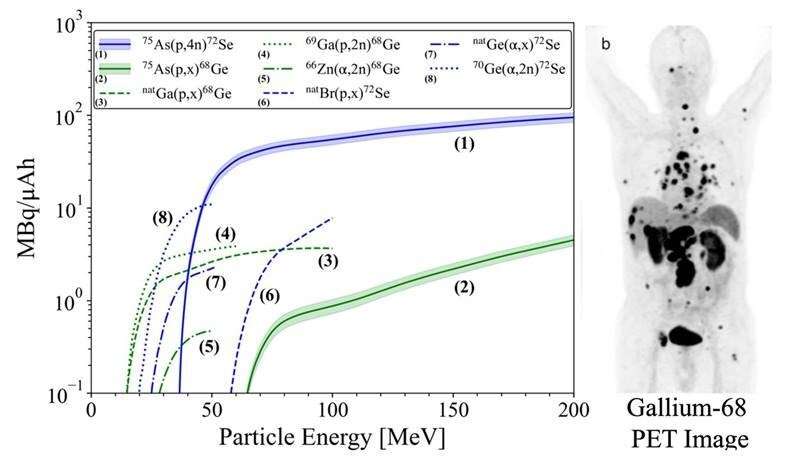Fighting cancer on Earth and in space using high-energy protons

Scientists on Earth use high-energy protons to create isotopes to detect and treat cancer. In space, however, these same high-energy protons can pose a risk to spacecraft and the health of the astronauts traveling in them. These risks mean spacecraft must have protective shielding. Unfortunately, scientists have a great deal of uncertainty concerning the risks posed by these high-energy protons. To learn more about the risks and about using these protons to produce isotopes, scientists measured the cross sections (probabilities) for high-energy proton reactions used to produce important new radiopharmaceuticals.
The Impact
Measuring these cross sections allows scientists to optimize the quantity and purity of medical isotopes needed in the fight against cancer. These include producing the pharmaceuticals arsenic-72-HBED and gallium-68-DOTATOC using high-energy protons from particle accelerators. Doctors use these pharmaceuticals to show where tumors have spread in the body. However, high-energy protons are also a dangerous type of space radiation.
Better understanding their behavior and reactions allows scientists to improve the design of shielding that protects astronauts and electronics in spacecraft. This will allow us to explore other planets in our solar system, while also helping understand how nuclei absorb and release energy.
Summary
Researchers from Brookhaven National Laboratory, Los Alamos National Laboratory, and Lawrence Berkeley National Laboratory performed a series of experiments using proton beams from the Brookhaven Linac Isotope Producer, the Los Alamos Isotope Production Facility, and the Berkeley Laboratory 88-Inch Cyclotron. These experiments measured production rates for 78 sotopes from the proton bombardment of niobium and arsenic targets with energies up to 200 MeV, including two radionuclides used for Positron Emission Tomography (PET) and one used to monitor the dose from proton beams in accelerators.
The team compared this large body of production data to predictions made using state-of-the-art nuclear reaction modeling codes to explore how quickly the energy from an incoming proton spreads throughout the entire nucleus when the two collide. The results showed a significantly slower rate of energy dissipation in the nucleus compared to what scientists previously believed.
This decrease, in turn, leads to an increase in the emission of additional "secondary" high-energy protons and neutrons, and also shows strikingly different rates when producing isotopes with different proton-to-neutron ratios. Taken together, these results provide guidance for the optimized production of the two PET radionuclides and will help in the design of shielding for spacecraft and their occupants from "secondary" particles caused by protons in cosmic radiation.
Research relating to this work was published last year in Physical Review C.
More information: Morgan B. Fox et al, Measurement and modeling of proton-induced reactions on arsenic from 35 to 200 MeV, Physical Review C (2021). DOI: 10.1103/PhysRevC.104.064615
Morgan B. Fox et al, Investigating high-energy proton-induced reactions on spherical nuclei: Implications for the preequilibrium exciton model, Physical Review C (2021). DOI: 10.1103/PhysRevC.103.034601



















